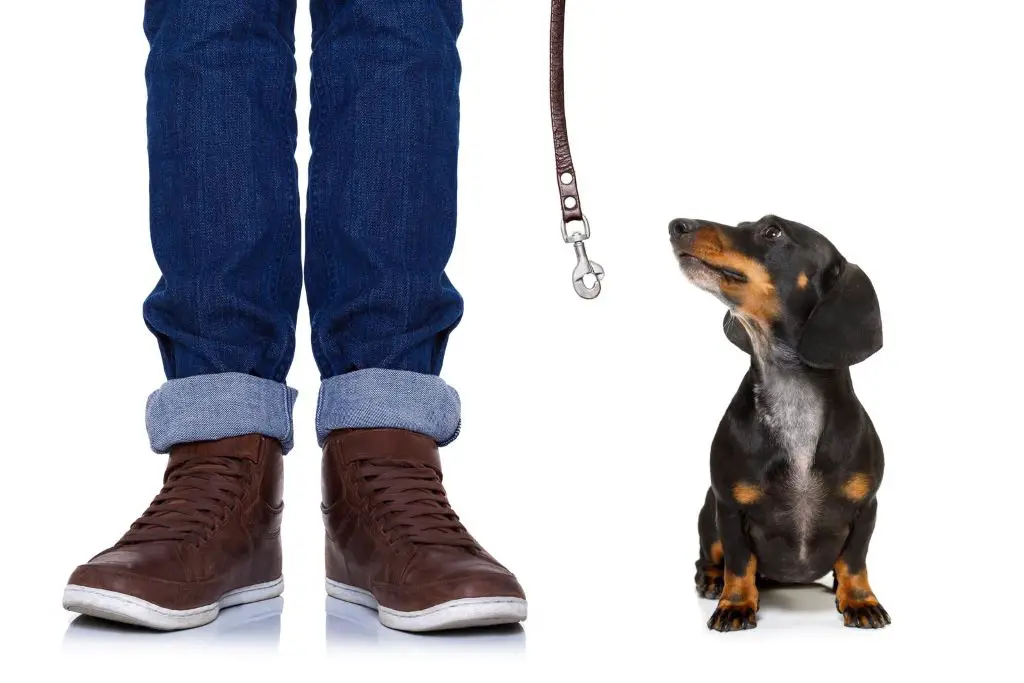When it comes to your Dachshund’s wellbeing, choosing the right walking accessory is more than a matter of style or convenience. The debate between a collar and a harness is a common one among Dachshund owners, and the answer isn’t as straightforward as it might seem. It hinges on various factors, including your Dachshund’s health, behavior, and lifestyle.
In this article, we will explore these factors in depth, compare the pros and cons of collars and harnesses, and provide expert advice to help you make the best choice for your Dachshund. Whether you’re a new Dachshund parent or an experienced owner, this guide is designed to equip you with the knowledge you need to ensure your Dachshund’s walks are safe and enjoyable. So, let’s dive in and learn more about caring for our Dachshunds.
Key Takeaways:
- Dachshunds’ unique body structure makes them prone to spinal issues like IVDD.
- Regular exercise and careful activity monitoring can help prevent back injuries in Dachshunds.
- Collars are easy to use but can put pressure on the Dachshund’s neck.
- Harnesses distribute pressure evenly, providing better control and safety.
- The choice between a collar and a harness should consider comfort, fit, durability, safety, and your Dachshund’s preference.
Understanding Dachshunds
Dachshunds, with their unique long bodies and short legs, are not only adorable but also prone to certain health issues. The most common among these is Intervertebral Disc Disease (IVDD), a spinal condition that can lead to severe pain or even paralysis.
The Importance of the Right Walking Accessory
The decision between a collar and a harness can significantly influence the pressure distribution on your Dachshund’s body, particularly their vulnerable spine. Therefore, it’s crucial to make an informed decision that prioritizes your Dachshund’s comfort and health.
In this guide, we will delve into the unique needs of Dachshunds, compare the pros and cons of collars and harnesses, and provide expert advice to help you make the best choice for your beloved pet. Whether you’re a new Dachshund parent or an experienced owner looking for insights, this guide is designed to equip you with the knowledge you need to ensure your Dachshund’s walks are safe and enjoyable.
Understanding Dachshunds and Their Needs
Dachshunds are a breed like no other, boasting a unique silhouette and a lively personality. They are available in two sizes – standard and miniature – and come with three different coat types: smooth, wirehaired, or longhaired. Their distinctive long body, short legs, and vibrant personality have made them a beloved choice among dog enthusiasts worldwide.
Physical Characteristics
Dachshunds are renowned for their elongated bodies and short legs, a physical structure that is not only charming but also predisposes them to certain health issues. Standard Dachshunds typically weigh between 16 to 32 pounds, while the miniature ones weigh 11 pounds or less. They are moderate shedders and are relatively clean, with little to no body odor.
Health Issues
The most prevalent health issue in Dachshunds is Intervertebral Disc Disease (IVDD), a spinal condition that can lead to severe pain or even paralysis. This condition is a consequence of their unique body structure, with a long spinal column and short rib cage. To prevent disc damage to the Dachshund’s long back, it’s crucial to prevent them from becoming overweight and to always monitor their activities to avoid back injury.
Exercise and Training Needs
Despite their small stature, Dachshunds require regular exercise to stay fit and build strong muscles to support and protect their back. Two walks of moderate length every day should be sufficient. However, to avoid injury, never allow your Dachshund to run up and down stairs or jump on or off furniture.
Dachshunds are intelligent but can also be independent and often stubborn, making them a challenge to train. They respond best to positive, reward-based training and do not react well to harsh commands or punishment. Patience and consistency are key when training a Dachshund.
Understanding these aspects of a Dachshund’s needs and characteristics will help you make an informed decision when choosing between a collar and a harness. In the next section, we will delve deeper into the pros and cons of each.
Collars vs. Harnesses for Dachshunds
When it comes to choosing between a collar and a harness for your Dachshund, it’s important to consider the unique needs and characteristics of the breed.
Collars for Dachshunds
- Fits 11-17" neck size and is 1" wide.
- Vibrant and bold, this beautiful polyester dog collar is made to show off your dog's unique style through all the seasons.
- With an overengineered plastic buckle and strong D-ring, this durable collar can hold up to whatever your dog can dish out.
- This product is handcrafted in the USA by Buckle-Down and is officially licensed by Buckle-Down.
- Matching leads/leashes available.
Pros of Using a Collar:
- Collars are generally easier to put on and take off compared to harnesses.
- They are less likely to cause matting or tangling in long-haired Dachshunds.
- Collars provide a place to attach identification tags.
Cons of Using a Collar:
- Collars can put pressure on the neck, which can be harmful to Dachshunds, especially those prone to IVDD.
- If a Dachshund pulls on the leash, a collar can cause coughing, choking, or other discomfort.
- Collars can slip over your Dachshund’s head. They also pose the risk of coming undone if your dog pulls with enough force.
Harnesses for Dachshunds
- Features neck adjustability for those dogs that are in between sizes
- Same comfort and look of the Soft Harness
- Adjustable chest belt
- Rubber Puppia label
Pros of Using a Harness:
- Harnesses distribute pressure more evenly across the chest and shoulders, reducing the risk of injury to the neck and spine.
- They provide better control over your Dachshund, which can be particularly useful if your dog tends to pull on the leash.
- Harnesses are less likely to come off accidentally, providing added security.
Cons of Using a Harness:
- Some Dachshunds may find harnesses uncomfortable or restrictive, especially if they’re not used to wearing one.
- Harnesses can cause matting or tangling in long-haired Dachshunds.
- They can be more difficult to put on and take off compared to collars.
In general, many Dachshund owners and experts recommend harnesses over collars, especially for walking and training. The key is to find a well-fitted, comfortable harness that your Dachshund is happy to wear. In the next section, we will provide tips on choosing the right collar or harness for your Dachshund.
Choosing the Right Harness or Collar for Your Dachshund
When it comes to selecting the right walking accessory for your Dachshund, there are several factors to consider.
Comfort and Fit
Whether you choose a collar or a harness, it should be comfortable for your Dachshund to wear. Consider a padded harness rather than the naked nylon type that can pull fur and chafe your dog’s skin. Also, pay attention to fit: If you can slide your index finger under the collar or harness, it’s probably loose enough to be comfortable but snug enough, so it won’t fall off.
Material and Durability
The material of the collar or harness is also important. It should be durable enough to withstand your Dachshund’s activities but soft enough not to cause discomfort. Look for materials that are easy to clean and maintain.
Safety
Safety is a crucial factor when choosing a collar or harness. A harness is generally considered safer for Dachshunds as it distributes pressure more evenly across the chest and shoulders, reducing the risk of injury to the neck and spine.
Training Needs
If you’re training your Dachshund, a harness might be a better option as it gives you more control. It can be particularly useful if your Dachshund tends to pull on the leash.
Your Dachshund’s Preference
Finally, consider your Dachshund’s preference. Some dogs might find a harness uncomfortable or restrictive, especially if they’re not used to wearing one. On the other hand, some Dachshunds might not like the feeling of a collar around their neck. It might take some trial and error to find out what your Dachshund prefers.
Remember, the goal is to ensure that walks are a positive and enjoyable experience for your Dachshund. Whether you choose a collar or a harness, the most important thing is that your Dachshund is comfortable, safe, and happy.
FAQs
Do Dachshunds need special harnesses?
Yes, Dachshunds can benefit from a special harness that is designed to distribute pressure evenly across their chest and shoulders, reducing the risk of injury to their neck and spine. Given their unique body structure, a harness that provides good support without putting undue pressure on their back is ideal.
Do vets recommend collars or harnesses for Dachshunds?
Most vets recommend harnesses over collars for Dachshunds due to their susceptibility to Intervertebral Disc Disease (IVDD). A harness can help distribute the force exerted when your Dachshund pulls on the leash, reducing the risk of injury to their neck and spine.
What is the correct way to carry a Dachshund?
When carrying a Dachshund, it’s important to support their back to prevent injury. One hand should go under their chest, and the other should support their rear end. Avoid letting their body dangle or bend excessively.
What type of harness is best for a Dachshund?
The best type of harness for a Dachshund is one that distributes pressure evenly across the chest and shoulders, reducing the risk of injury to the neck and spine. It should be well-fitted, comfortable, and easy to put on and take off. A back-clip or dual-clip harness is often recommended for Dachshunds.
Can a Dachshund wear a collar?
While a Dachshund can wear a collar, it’s generally not recommended for walking or training due to the risk of injury to their neck and spine. However, a collar can be useful for attaching identification tags.
Wrapping Things Up
Choosing between a collar and a harness for your Dachshund is a decision that should be made with careful consideration of their unique needs and characteristics.
While collars may be simpler to use, harnesses are generally recommended for Dachshunds due to their ability to distribute pressure more evenly and reduce the risk of neck and spine injuries. Ultimately, the best choice will depend on your Dachshund’s comfort, health, and safety.
Whether you choose a collar or a harness, the most important thing is to ensure that your Dachshund’s walks are a positive and enjoyable experience.











